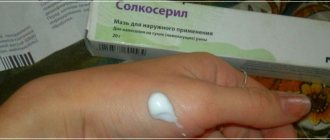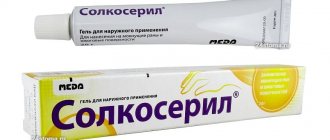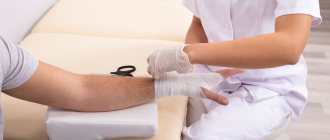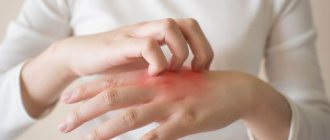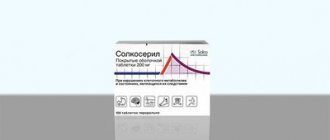From this article you will learn:
- What does Solcoseryl ointment help with?
- indications and regimens for use,
- application in cosmetology against wrinkles.
The article was written by a specialist with higher medical education.
Solcoseryl ointment is a preparation containing deproteinized dialysate from the blood of calves, which is an effective stimulator of healing of skin lesions and the red border of the lips. Here you need to pay attention to the fact that the drug is intended for application only to those wounds that do not have wet discharge. If the wound surface is wet or has discharge, in this case only Solcoseryl in gel form should be used.
The drug is registered as a “medicine” and is intended exclusively for external use. The drug is produced by pharma (Switzerland) and has no age restrictions, and is also not contraindicated for use in lactating and pregnant women. The latter indicates a high safety profile and a low risk of developing allergies. The ointment is a homogeneous white fatty mass, which has a characteristic smell of petroleum jelly and meat broth (the latter is associated with production technology).
Solcoseryl ointment: photo of the drug
What is Solcoseryl ointment used for?
The drug is based on deproteinized dialysate obtained through special processing from the blood of calves. This substance is often used in medicine in countries such as China, Korea, and the entire CIS. It has proven itself to be an effective remedy that can:
- enrich tissue cells damaged due to hypoxia with oxygen and glucose;
- start tissue repair processes;
- activate healthy cell division processes;
- increases the level of energy produced by cells;
- protects the skin from external damage by forming a film on its surface;
- triggers the production of collagen by tissues.
Based on the activity of the drug, the drug can be used for:
- frostbite;
- psoriasis;
- anal ring cracks;
- cuts;
- abrasions;
- scratches;
- bedsores;
- acne marks;
- dermatitis;
First of all, to achieve the best effect, it is necessary to start therapy in the early stages of the problem.
Comparison of ointment and gel Solcoseryl
Regardless of the form in which the drug is released, its effect on damaged surfaces is the same: the components protect tissue cells, saturate them with oxygen, stimulate restoration and reparative processes, activate the formation of new tissue cells and the formation of collagen compounds.
Both forms of the drug have the same effect on the affected tissue.
Similarities
Both forms of the drug have the same effect on the affected tissue. The method of using ointment and gel is also similar: they are applied to the affected areas, pre-treated with an antiseptic, 1-2 times a day. The therapeutic effect is based on a single active component. In case of severe damage, it is permissible to apply a medicinal application.
Differences
The difference between the drugs lies in the concentration of the active substance (there is more of it in the gel) and in the list of additional ingredients.
The drugs and areas of application differ. The gel base is aqueous, there are no fatty components in its composition, so the texture is lighter. Treatment of complex injuries should begin with the use of the gel. It is most suitable for treating weeping wounds, deep fresh injuries, accompanied by wet discharge. The gel will help remove exudate and activate the formation of new connective tissue.
The ointment has a greasy and viscous texture. Its use begins at the stage of wound healing, when the process of epithelization has already begun at its edges. The ointment will have not only a healing, but also a softening effect. By forming a protective film, it will prevent the appearance of crusts and cracks on the healing surface.
The ointment has a greasy and viscous texture.
Which is cheaper?
The cost depends on the form of the drug and the concentration of the active substance. The price of the ointment is 160-220 rubles. per tube weighing 20 g. The cost of the same amount of gel ranges from 170 to 245 rubles.
Solcoseryl ointment as a face mask
Cosmetologists claim that the use of Solcoseryl in the early stages of age-related changes allows you to maintain youthful skin. Timely start of use can replace expensive laser rejuvenation in the salon. First of all, Solcoseryl allows you to get rid of wrinkles and prevent their earlier appearance. The ointment is capable of:
- provide adequate nutrition to the facial skin;
- get rid of acne;
- relieve inflammation;
- improve complexion;
- tighten the oval;
- get rid of wrinkles.
The expected effects are possible due to the fact that using a mask allows you to saturate tissues and cells with oxygen and accelerate regeneration. Thanks to the application of the cream, collagen, which is responsible for skin elasticity, begins to be actively produced. The more collagen produced, the fewer wrinkles your skin will have. It is like a support for a heavy skin sheet, preventing its individual areas from falling through, preventing the formation of wrinkles.
Solcoseryl injections: what for
Any surgical intervention is accompanied by a violation of the integrity of the skin and tissues. If the operation involves the removal of some fragment of an internal organ, the body will require a long rehabilitation period, during which the body will be fully or partially restored. Solcoseryl in ampoules can be instantly delivered to tissues, shortening the recovery period. Injections allow you to mobilize all the internal forces of the body to heal wounds, cuts and sutures not only on the outside, but on the internal organs that remain after operations.
Special cases include the prescription of intravenous or intramuscular administration to patients after ophthalmological operations. Solcoseryl ensures active blood circulation, which accelerates the process of adaptation of the organ of vision in the postoperative period, and also reduces the risk of complications.
Description of the drug
Solcoseryl is a universal stimulator of tissue regeneration. The drug is obtained through calf blood dialysis (molecular crushing followed by removal of protein compounds). The main area of application is restoring the integrity of the skin after mechanical and thermal damage. The medication helps with the following problems: burns, ulcers, scratches, abrasions, pimples, acne, etc.
Solcoseryl - detailed instructions for using ointment and gel
Regardless of the form of release of the drug, the principle of influencing problem areas of tissue is common: the components protect affected and healthy cells, saturate them with oxygen; activate regeneration and repair reactions, stimulate the synthesis of new tissues at the cellular level, increase the intensity of the formation of collagen compounds.
As for the differences, the ointment differs from the gel in the composition of auxiliary ingredients and the concentration of the active substances a.
Pharmacological action and group
Solcoseryl belongs to the group of biogenic stimulants. The drug is identified in several pharmacological groups:
- reparants and regenerants;
- microcirculation correctors;
- antioxidants and antihypoxants.
The pharmacological action of the drug indicates its versatility - cytoprotective, membrane stabilizing, angioprotective, wound healing, antihypoxic and regenerating. These properties allow the drug to quickly solve the most complex skin problems.
The main active ingredient of the drug is deproteinized dialysate, as well as a number of auxiliary ingredients. Their main effect is to optimize aerobic metabolism and normalize oxidative phosphorylation reactions. As part of the in vitro studies, the following properties of the pharmaceutical product were established:
- activates collagen synthesis;
- stops inflammatory processes, accompanying reactions, prevents their spread to healthy tissues;
- increases the intensity of regeneration and repair in affected areas;
- normalizes intracellular nutrition, including after oxygen starvation.
After applying the medicine in a thin layer to the surface of the damaged area of the skin, the composition protects cellular structures and promotes their rapid recovery and regeneration.
Composition and release form
The active component of the drug, regardless of its form, is an extract from the blood of mammary bodies. So what is the difference between gel and ointment? – In the concentration of the main substance and auxiliary ingredients.
The ointment composition includes a number of minor components:
- injection purified water;
- medical Vaseline;
- cholesterol;
- cetyl alcohol.
Auxiliary ingredients of the gel:
- injection water;
- propylene glycol;
- sodium carboxymethylcellulose;
- calcium lactate.
Both forms of the drug are supplied in aluminum tubes of 20 g. Each “tube” of the pharmaceutical product is in a separate cardboard package, complete with annotation and instructions for use.
How to inject Solcoseryl for gastritis
Gastritis is a disease of the gastric mucosa that can occur for various reasons. Solcoseryl ampoules will not become the main drug used in the treatment of gastritis, but it can speed up the healing process, while the prescribed therapy will relieve the patient of the source of the problem.
The gastric mucosa can become inflamed not only as a result of poor nutrition, but also as a result of infection with gastrointestinal infections. The attending physician will first conduct an examination and evaluate the test results, which will allow him to prescribe effective therapy. Solcoseryl will be used as an addition to the main treatment, as it will help the stomach tissues to regenerate faster, ulcers to heal, and inflammation to disappear.
Branch
An anal fissure is a defect in the form of a tear or open wound (ulcer) in the lining of the anal canal.
The anal canal is the final part of the large intestine, located between the rectum (the reservoir of stool) and the anus, through which stool passes out.
Symptoms of anal fissure
The most common symptoms are:
- acute pain at the time of defecation, which is accompanied by burning pain and can last for several hours.
- bleeding after bowel movements, which most people characterize as a small amount of scarlet blood in the stool or traces of blood on toilet paper.
When to go to the doctor
Go to the doctor if you think you have an anal fissure. Put aside the embarrassment, the problem of anal fissure is the third most common problem in the structure of diseases of the colon.
In most cases, anal fissures do not require any specialized treatment. However, contacting a specialized specialist will help rule out other diseases that occur under the guise of an anal fissure.
The doctor will also provide recommendations for individual treatment that will help relieve your symptoms and reduce the risk of relapse of the disease.
How is an examination performed for anal fissure?
The doctor will ask you about your symptoms and find out the nature of your pain. He may ask you about the frequency and nature of bowel movements. And, for sure, the doctor will need to examine the crack itself, by carefully spreading the buttocks.
When diagnosing an anal fissure, digital examination of the rectum is not always performed, as it can be painful.
If, in the opinion of a coloproctologist, an anal fissure is a manifestation of any of your other diseases, he can expand the examination and involve other specialists in consultation.
An extended examination may include a more detailed examination of the anus using an anesthetic to reduce pain.
In some cases, with fissures that are not amenable to conventional treatment, it is necessary to assess the tone of the anal sphincter (the sphincter is a muscular ring that opens and closes the anus).
What causes anal fissure?
— Constipation is the most common cause. Hard or large-volume fragments of feces damage the lining of the anal canal.
Other possible causes of anal fissures include:
- prolonged diarrhea.
- inflammatory diseases of the colon such as Crohn's disease and ulcerative colitis.
- pregnancy and childbirth.
- in some cases, sexually transmitted infections such as syphilis and herpes.
- a state of strong contraction (spasm) of the anal sphincter, leading to increased pressure in the anal canal, which contributes to its damage.
In many cases, the cause of an anal fissure is difficult to determine.
Who gets sick?
Every tenth person will develop anal fissure at one time or another in their lives.
Men and women of all age groups are equally prone to the formation of anal fissures. However, in most cases, cracks occur in children and young people aged 10 to 30 years.
Treatment and prevention of anal fissures.
Anal fissures usually heal within a few weeks or more without any treatment. However, the relapse rate is very high if the underlying cause of their occurrence, constipation, persists.
In some patients, symptoms of anal fissure may persist for 6 weeks or more (chronic form of the disease).
Measures taken independently by patients aimed at making stool easier can speed up the healing of existing cracks and reduce the risk of developing new cracks in the future.
To reduce pain, you can take regular painkillers (paracetamol or ibuprofen). Take warm baths for the perineum several times a day, preferably immediately after bowel movements during bowel movements.
Your doctor may recommend additional medications that will reduce the severity of your symptoms and help speed up the healing process.
The treatment regimen may also include pain-relieving ointments and laxatives, which make bowel movements easier.
Surgical treatment may be recommended for long-term non-healing cracks that are not amenable to conservative measures.
Surgery is an effective treatment for anal fissure in most cases. But, like any other operation, it can lead to complications, such as temporary or permanent loss of bowel control (incontinence of stool and gas).
Treatment of anal fissures.
Like any minor cuts or breaks in the skin, anal fissures often heal on their own within a few weeks.
However, if you have an anal fissure, it is better to consult a doctor who will prescribe you the necessary treatment, which will help you quickly get rid of the symptoms of the disease and make a full recovery.
Most anal fissures can easily recur after conservative treatment if you do not follow the recommendations below.
Independent activities.
There are several independent measures to relieve constipation, which in turn helps reduce pain with anal fissures.
Eliminating constipation allows you to heal an anal fissure and reduce the risk of its further development in the future.
Self-help measures to relieve constipation:
- Increase your daily dietary fiber intake by including high-fiber foods such as fruits, vegetables and whole grains.
- Avoid dehydration, drink more fluids and just water.
- Get more exercise. For example, take a daily walk or jog.
- Choose a convenient place and time when you can comfortably go to the toilet to have a bowel movement.
- Don't put off going to the toilet if you feel the urge to defecate.
- If you use wet wipes, make sure they do not contain fragrances or alcohol, which may cause discomfort or itching. If you use toilet paper, choose a soft variety and avoid using too much pressure when wiping.
- Take warm perineal baths several times a day, especially after bowel movements. This helps relieve spasm of the anus muscles.
Drugs.
There are a number of different medications that can be recommended by your doctor to reduce the symptoms of an anal fissure and speed up its healing.
Laxatives
Laxatives are a group of medications that promote freer passage of stool.
Adult patients with anal fissure are prescribed drugs that increase the volume of intestinal contents and osmosis.
Children with anal fissure are prescribed liquid forms of osmotic laxatives.
As a rule, treatment begins with small doses of laxatives. If necessary, the dose of the drug is increased every few days until loose, soft stools are established with a frequency of 1 time per day or 1 time every 2 days.
Attention! Without dieting, laxatives only help for a limited period of time. Do not use them for more than 7-10 days.
Painkillers
If you have prolonged burning pain after bowel movements, your doctor may recommend regular over-the-counter pain relievers such as paracetamol or ibuprofen.
But remember that some painkillers can cause constipation. Read the instructions carefully.
Ointment with nitroglycerin (glyceryl trinitrate)
If your symptoms do not go away within a week or two, you may be prescribed a topical ointment containing nitroglycerin. The ointment is applied directly to the crack area, usually 2 times a day.
Glycerin ointment promotes the expansion of blood vessels in the tissues surrounding the anus, which promotes better blood supply to the tissues in the fissure and, as a result, faster healing.
The use of these ointments leads to a decrease in pressure in the anal canal by relieving muscle spasms, which helps reduce pain.
Most acute anal fissures that last less than 6 weeks are cured with nitroglycerin ointment. In approximately seven cases of chronic anal fissure out of ten, with the correct use of nitroglycerin ointment, recovery occurs.
A common side effect of using nitroglycerin ointment is headache, occurring in 50% of patients.
Some patients experience dizziness or slight disturbances of consciousness after applying nitroglycerin ointment. Therefore, the ointment should be used with caution in children, pregnant and lactating women.
If you are bothered by headaches, you should reduce the amount of ointment applied. Using a small amount of ointment 5-6 times a day may be more effective than applying a large amount of ointment twice.
Apply the ointment only to the skin around the anus. Avoid getting the ointment into the anal canal.
As a rule, the duration of treatment with nitroglycerin ointment is approximately 6 weeks or continues until the crack is completely healed.
Local anesthetics
If you are experiencing severe pain, you may be advised to use a local anesthetic to reduce the sensitivity of the anus before bowel movements.
Local anesthetics are applied directly to the affected area. Their use does not have a direct therapeutic effect, but helps relieve pain.
The most commonly used anesthetic to treat anal fissure is lidocaine. Used as an ointment or gel. The duration of treatment is 1-2 weeks. As a rule, healing occurs within this time frame.
Calcium channel blockers
Calcium channel blockers, such as Diltiazem, are drugs commonly used to treat high blood pressure (hypertension).
At the same time, the effect of calcium channel blockers extends directly to the tissues around the anus, providing a proven positive effect in the healing of anal fissure in some patients.
Topical use of calcium channel blockers helps relax the anal sphincter muscles and improve blood flow in the tissues surrounding the anal fissure.
Side effects of calcium channel blockers include headache, dizziness, itching and burning at the site of application. All side effects of the drug disappear within a few days after use.
Topical calcium channel blockers are as effective as nitroglycerin ointments and are prescribed when other drugs do not help.
The duration of treatment with topical calcium channel blockers, as well as nitroglycerin ointment, lasts on average 6 weeks or until complete healing.
Botulinum toxin injections
The use of botulinum toxin in the treatment of anal fissure is a relatively new method of treatment. The method is used when other treatment methods are not effective. Botulinum toxin is a strong poison that is safe to use in small doses.
Botulinum toxin injections for anal fissure are performed in order to achieve paralysis of the anal sphincter muscles. This prevents muscle spasm, relieves pain and promotes healing of the crack. Currently, evaluation of the effectiveness of botulinum toxin in the treatment of anal fissure is ongoing.
The effect of botulinum toxin lasts for 2-3 months. This time is usually enough for the anal fissure to completely heal.
Observation
After several weeks of treatment, you should visit your doctor again. He will objectively assess the dynamics of the disease.
If the crack has completely healed, your doctor will schedule a follow-up examination in a few weeks.
If your anal fissure is a complex case and does not respond to treatment within 8 weeks, a consultation with a coloproctologist is necessary. He will assess the presence of indications for surgical treatment.
Operation
Surgical treatment is recommended if conservative treatment methods are ineffective.
Surgery is considered the most effective method for anal fissure, allowing to achieve good long-term results in 90% of cases. At the same time, there is a risk of complications.
There are a number of surgical operations used for anal fissure.
Lateral sphincterotomy
The lateral sphincterotomy technique involves making a small incision in the circular muscles of the anal sphincter, which reduces tension in the anal canal. Reducing stress promotes healing of the damage and reduces the chances of cracks reoccurring.
This is a relatively simple operation that is performed under general or epidural anesthesia. This means that you do not feel pain during the operation. Most often, the patient is in the hospital for the duration of the operation and a short period after the operation.
Lateral sphincterotomy is one of the most effective surgical methods for treating anal fissure with good long-term results. Most operated patients recover completely within 2-4 weeks.
Some patients (about 5%) who have undergone such an intervention are faced with the problem of incontinence of loose stools and gases as a result of damage to the muscular structures of the anal sphincter. Sphincter function recovers on its own within a few weeks.
Replacement of the defect with a skin flap
Skin flap surgery involves moving a piece of blood-supplied skin from another area of your body to the site of the anal defect to improve blood circulation in the tissues surrounding the crack.
This operation is recommended for the treatment of long-term anal fissures caused by pregnancy or trauma to the anal canal.
Which is better: Metrogyl Denta or Solcoseryl
Both drugs can be used in the treatment of stomatitis. However, it is better to consider them not as drugs of choice, but from the point of view of a combination of two types of gels. The thing is that stomatitis is most often caused by bacterial infection of the tissues of the oral cavity, which causes the appearance of wounds and ulcers. Metrogyl Denta is an antimicrobial drug with a pronounced antibacterial effect. At the same time, everyone who has encountered stomatitis at least once knows how much one wants to speed up the healing process of ulcers that cause severe pain, especially when eating food. Solcoseryl can force tissue to regenerate as quickly as possible, which ensures prompt healing of wounds.
Contraindications and side effects –
The only contraindication for use is the presence of hypersensitivity to any of the components of the drug. The ointment has no contraindications depending on age, as well as contraindications for use during pregnancy and lactation.
However, if you are predisposed to allergic reactions (especially to cosmetics or oral hygiene products), you should use this drug with caution. An allergic reaction to Solcoseryl ointment usually develops as urticaria or dermatitis. If an allergy occurs, you should stop using the drug. Please note that when applying the ointment, a short-term burning sensation may appear (this is absolutely normal), but if the burning does not go away, then the ointment should be washed off and further use of the drug should be discontinued.
Special instructions -
- Solcoseryl ointment should not be applied to contaminated, infected wounds, because the drug does not contain antimicrobial components. Also, the ointment is not suitable for treating wounds with wet discharge (here you need a form of Solcoseryl in the form of a gel).
- If you experience pain, swelling, redness, a fistula with discharge near the site where the ointment was applied, or an increase in body temperature, you should immediately consult your doctor, because these are the first symptoms of purulent inflammation.
- If, while using the drug, your wound does not heal (about 2 weeks), you should immediately consult a doctor, because this may indicate the presence of a benign or malignant tumor. We hope that our article on the topic: What is Solcoseryl ointment used for, treatment regimens - turned out to be useful to you!
Sources:
1. Higher medical education of the author of the article, 2. Additional professional education in the field of cosmetology, 3. Personal experience as a maxillofacial surgeon, 4. https://solcolife.ru/.
Which is cheaper: Actovegin or Solcoseryl
Actovegin is a complete analogue of Solcoseryl. Its active ingredient is deproteinized calf blood dialysate. The release forms of Actovegin do not differ from those in which Solcoseryl can be found. Tablets and ampoules for intravenous administration are prescribed for the same indications. Actovegin is a prescription drug, like Solcoseryl. Therefore, they can be considered as the same substance, sold under different names. This means that when one of them is not available in the pharmacy, the pharmacist has every right to offer an analogue as a replacement. However, when comparing price categories, Solcoseryl should be given preference, because its cost is lower than Actovegina.
